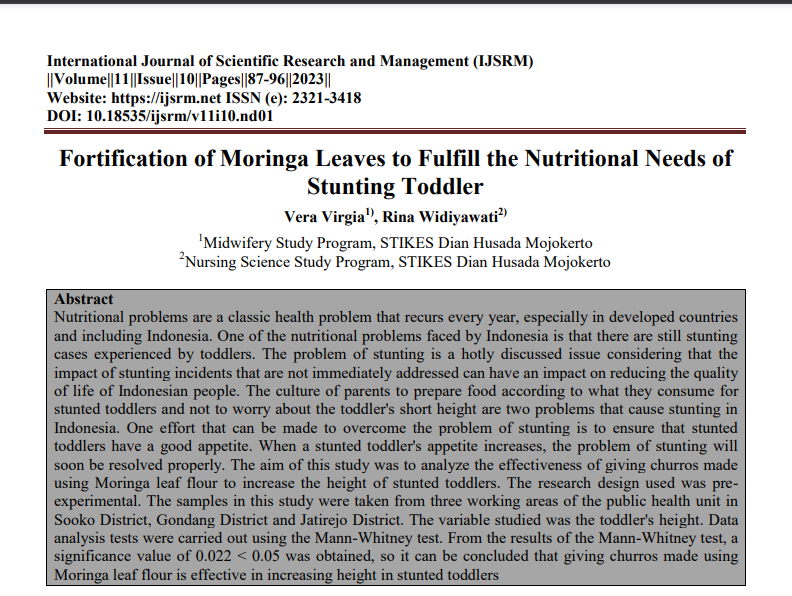
Submission to VIJ 2023-10-11
Keywords
- Churros,
- Moringa,
- Toddlers,
- Stunting
Copyright (c) 2023 Vera Virgia, Rina Widiyawati

This work is licensed under a Creative Commons Attribution 4.0 International License.
Abstract
Nutritional problems are a classic health problem that recurs every year, especially in developed countries and including Indonesia. One of the nutritional problems faced by Indonesia is that there are still stunting cases experienced by toddlers. The problem of stunting is a hotly discussed issue considering that the impact of stunting incidents that are not immediately addressed can have an impact on reducing the quality of life of Indonesian people. The culture of parents to prepare food according to what they consume for stunted toddlers and not to worry about the toddler's short height are two problems that cause stunting in Indonesia. One effort that can be made to overcome the problem of stunting is to ensure that stunted toddlers have a good appetite. When a stunted toddler's appetite increases, the problem of stunting will soon be resolved properly. The aim of this study was to analyze the effectiveness of giving churros made using Moringa leaf flour to increase the height of stunted toddlers. The research design used was pre-experimental. The samples in this study were taken from three working areas of the public health unit in Sooko District, Gondang District and Jatirejo District. The variable studied was the toddler's height. Data analysis tests were carried out using the Mann-Whitney test. From the results of the Mann-Whitney test, a significance value of 0.022 < 0.05 was obtained, so it can be concluded that giving churros made using Moringa leaf flour is effective in increasing height in stunted toddlers
References
- Archda, R., & Tumangger, J. (2019). Hulu-hilir penanggulangan stunting di Indonesia.
- Chalik, I. (2023). Daun Kelor Miliki Kandungan Protein Berfungsi Cegah Stunting. 6–9. https://bengkulu.bkkbn.go.id/daun-kelor-miliki-kandungan-protein-berfungsi-cegah-stunting/#:~:text=Dari daunnya yang kecil terdapat,otak anak akibat kekurangan gizi”.
- Dasman, H. (2019). Empat dampak stunting bagi anak dan negara Indonesia. The Conversation, 1.
- Fertiasari, R., Asta, H., & Kristiandi, K. (2022). Pelatihan Tepung Beras Fortifikasi Guna Menurunkan Kejadian Stunting di Desa Tebas Kabupaten Sambas. Indonesia Berdaya, 3(4), 1039–1044.
- Haskas, Y. (2020). Gambaran Stunting di Indonesia. Jurnal Ilmiah Kesehatan Diagnosis, 15(2), 154–157.
- Helmyati, S., Atmaka, D. R., Wisnusanti, S. U., & Wigati, M. (2020). STUNTING: Permasalahan dan Penanganannya. UGM PRESS.
- Peraturan Menteri Kesehatan Republik Indonesia Nomor 2 Tahun 2020 Tentang Standar Antropometri Anak, 1 (2020). http://hukor.kemkes.go.id/uploads/produk_hukum/PMK_No__2_Th_2020_ttg_Standar_Antropometri_Anak.pdf
- Kemenkes RI, K. K. R. I. (2022). Buku Saku Hasil Survei Status Gizi Indonesia (SSGI) Tahun 2022 - Badan Kebijakan Pembangunan Kesehatan | BKPK Kemenkes. https://www.badankebijakan.kemkes.go.id/buku-saku-hasil-survei-status-gizi-indonesia-ssgi-tahun-2022/
- Kemenko PMK, K. K. B. P. M. D. K. R. I. (2019). Strategi Nasional Percepatan Pencegahan Anak Kerdil (Stunting) Periode 2018-2024. In Sekretariat Wakil Presiden Republik Indonesia.
- Letiora, J. A. S., Sineke, J., & Purba, R. B. (2020). Tingkat Kesukaan Bubuk Daun Kelor untuk Formula Makanan Balita Stunting. Jurnal GIZIDO, 12(2), 105–112.
- Muliawati, D., & Sulistyawati, N. (2019). PEMBERIAN EKSTRAK MORINGA OLEIFERA SEBAGAI UPAYA PREVENTIF KEJADIAN STUNTING PADA BALITA The Use of Moringa Oleifera Exctract to Prevent Stunting in Toddler. Jurnal Kesehatan Madani Medika, 10(2), 123–131.
- Muliyati, H., & Hutagaol, I. O. (2020). Formulasi Biskuit Sumber Energi Dan Protein dari Tepung Daun Kelor (Moringa Oleifera) dan Tulang Ikan Sidat (Anguila Sp) untuk Baduta Stunting. Ghidza: Jurnal Gizi Dan Kesehatan, 4(1), 11–21. https://doi.org/10.22487/ghidza.v4i1.30
- Nirmalasari, N. O. (2020). Stunting Pada Anak: Penyebab dan Faktor Risiko Stunting di Indonesia. Qawwam, 14(1), 19–28.
- Oyeyinka, A. T., & Oyeyinka, S. A. (2018). Moringa oleifera as a food fortificant: Recent trends and prospects. Journal of the Saudi Society of Agricultural Sciences, 17(2), 127–136. https://doi.org/10.1016/j.jssas.2016.02.002
- Panatariono, T. A., & Puspitasari, Y. (2022). Determinants Factors of Stunting in Together in East Kambingan Village and Talang Village , Saronggi District , Sumenep. Journal for Quality in Public Health, 6(1), 164–176.
- Pemkab Mojokerto, P. K. M. (2023). Kabupaten Mojokerto Dalam Angka 2023. In Jurnal Penelitian Pendidikan Guru Sekolah Dasar (2022nd ed.). https://mojokertokab.bps.go.id/publication/download.html?nrbvfeve=NGRiMDE3YmQ0ZDJkY2Q4YzgxODNiOWJh&xzmn=aHR0cHM6Ly9tb2pva2VydG9rYWIuYnBzLmdvLmlkL3B1YmxpY2F0aW9uLzIwMjMvMDIvMjgvNGRiMDE3YmQ0ZDJkY2Q4YzgxODNiOWJhL2thYnVwYXRlbi1tb2pva2VydG8tZGFsYW0tYW5na2EtMjA
- Rahmadhita, K. (2020). Permasalahan Stunting dan Pencegahannya. Jurnal Ilmiah Kesehatan Sandi Husada, 9(1), 225–229.
- Rustamaji, G. A. S., & Ismawati, R. (2021). Daya terima dan kandungan gizi biskuit daun kelor sebagai alternatif makanan selingan balita stunting. Jurnal Gizi Unesa, 01(01), 31–37.
- Sumartini, E. (2020). Studi Literatur : Dampak Stunting Terhadap Kemampuan Kognitif Anak. Jurnal Seminar Nasional, Vol.2, No., 127–134.
- Susanti, D. F. (2022). Mengenal Apa itu Stunting ? Direktorat Jenderal Pelayanan Kesehatan Kementerian Kesehatan Republik Indonesia, 1. https://dinkes.karanganyarkab.go.id/?p=3713
- UNICEF Indonesia, U. N. C. F. I. (2019). Kerangka Aksi untuk gizi Ibu dan Makanan Pendamping Asi. Unicef Indonesia. https://www.unicef.org/indonesia/id/media/2686/file/Kerangka-Aksi-Gizi-Ibu-2019.pdf
- Wahyuni, D., & Fithriyana, R. (2020). Pengaruh Sosial Ekonomi Dengan Kejadian Stunting Pada Balita Di Desa Kualu Tambang Kampar. PREPOTIF : Jurnal Kesehatan Masyarakat, 4(1), 20–26. https://doi.org/10.31004/prepotif.v4i1.539
- Z. Suhaemi, Husmaini, E. Yerizal, & N. Yessirita. (2021). Pemanfaatan Daun Kelor (Moringa oleifera) dalam Fortifikasi Pembuatan Nugget. Jurnal Ilmu Produksi Dan Teknologi Hasil Peternakan, 9(1), 49–54. https://doi.org/10.29244/jipthp.9.1.49-54